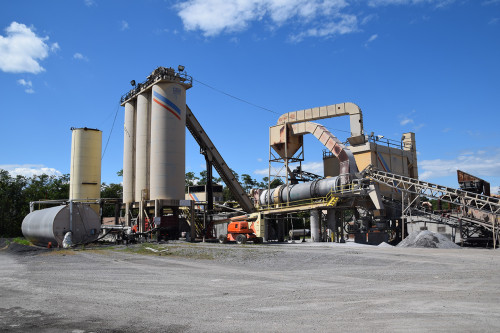Experience the Distinction: Hot Mix Asphalt Paving for Regrading Projects
Experience the Distinction: Hot Mix Asphalt Paving for Regrading Projects
Blog Article
Opening the Secrets of Hot Mix Asphalt Modern Technology
Discovering the midsts of warm mix asphalt modern technology reveals a world where meticulous processes and accurate formulas converge to form our roads and facilities. The fusion of aggregates, fillers, and binders isn't just a construction job yet a calculated orchestration of resilience and effectiveness. As we peer right into the detailed dancing of elements, a tapestry of resilience and sustainability unfolds. What lies under this surface area of asphaltic mastery, and what tricks wait to be introduced in the realm of leading technologies?
Value of Warm Mix Asphalt
Warm Mix Asphalt plays a critical function in modern-day facilities growth because of its toughness and cost-effectiveness. As the most frequently used paving product for roadways, highways, and parking area, Hot Mix Asphalt supplies a variety of benefits that add to its importance in building and construction jobs. One key benefit is its capability to withstand rush hour tons and severe climate condition, providing a resilient and dependable surface area for transportation networks. Furthermore, Warm Mix Asphalt is cost-efficient in both preliminary building and construction and long-term upkeep, making it a recommended selection for lots of framework projects.
The longevity of Hot Mix Asphalt originates from its structure, that includes accumulations, binder, and filler products that are meticulously chosen and blended to fulfill details efficiency demands. This specific mix leads to a strong and adaptable pavement that can withstand frequent use without significant wear and tear. Hot Mix Asphalt is 100% recyclable, more enhancing its sustainability and environmental advantages. On the whole, the relevance of Warm Mix Asphalt in facilities development can not be understated, as it remains to be a cornerstone of modern-day building and construction methods.
Components of Asphalt Mixes
The composition of asphalt blends consists of very carefully picked aggregates, binder, and filler materials that are vital for achieving particular performance demands. Accumulations are the key element of asphalt blends, giving strength and stability. The binder, generally asphalt or asphalt concrete, holds the accumulations with each other and provides flexibility and toughness to the mix.
The combination and proportion of these elements play a significant duty in determining the high quality and performance of the asphalt mix. Engineers very carefully design the mix to meet particular requirements, taking into consideration factors like web traffic quantity, environment problems, and pavement lifespan. Correct option and harmonizing of accumulations, binder, and fillers are necessary for developing durable, long-lasting asphalt pavements.
Combining and Manufacturing Strategies

As soon as the accumulations are selected, the binder, frequently asphalt cement, is included to bind the materials with each other. The binder's high quality and quantity considerably impact the mix's resistance, versatility, and stamina to environmental elements. Additionally, fillers like hydrated lime or Rose city concrete may be integrated to improve particular qualities of the asphalt mix, such as its workability or dampness resistance.
Throughout manufacturing, the accumulations and binder are heated up, usually between 250-325 ° F(121-163 ° C ), to help with mixing and guarantee proper covering of the aggregates. The blending process should be extensive to accomplish a homogeneous combination that advertises the desired performance characteristics of the asphalt. Numerous techniques, such as batch blending or drum mixing, are utilized to achieve top quality and constant asphalt mixes for construction jobs.
Factors Impacting Asphalt Performance
Aspects influencing asphalt efficiency include a range of variables that influence the sturdiness, longevity, and overall quality of asphalt sidewalks. One essential factor is the high quality of materials utilized in the asphalt mix. The kind and source of accumulations, the binder quality, and the ingredients all play a significant duty in identifying the performance of the asphalt sidewalk. The gradation of accumulations is essential as it influences the mix's stability, workability, and resistance to fracturing and rutting.

Ecological conditions additionally influence asphalt efficiency. Temperature variations, moisture seepage, and web traffic lots can all affect the architectural stability of the sidewalk. Layout considerations, such as sidewalk thickness and water drainage, are vital in ensuring the long-term efficiency of the asphalt pavement. By very carefully considering these elements, contractors and designers can enhance asphalt efficiency and boost the life span of sidewalks.
Sustainable Practices in Asphalt Modern Technology

WMA enables for the production and positioning of asphalt blends at lower temperature levels contrasted to traditional hot-mix asphalt, resulting in minimized energy usage and greenhouse gas exhausts. The use of permeable asphalt mixes can assist alleviate stormwater drainage problems by permitting water to infiltrate with the sidewalk and into the ground, promoting natural water filtration and recharge processes.
Final Thought
Finally, warm mix asphalt innovation plays an essential function in modern infrastructure advancement because of its resilience and cost-effectiveness. By thoroughly balancing components, using correct blending techniques, and taking into consideration numerous variables, designers can develop top quality asphalt mixes that stand up to rush hour lots and harsh weather condition conditions. Welcoming sustainable practices, such as utilizing warm-mix technologies and recycled products, better enhances the ecological kindness of asphalt modern technology.
Mixing and production techniques in warm mix asphalt modern technology include the accurate mix and handling of accumulations, binder, and fillers to produce a high-performance and resilient asphalt mix.Factors affecting asphalt efficiency encompass a range of variables that influence the sturdiness, longevity, and overall top quality of asphalt sidewalks. Sustainable techniques in asphalt innovation include various campaigns aimed at decreasing the ecological effect of asphalt production and paving procedures. By integrating reclaimed asphalt sidewalk (RAP) and recycled asphalt shingles (RAS) right into brand-new asphalt blends, the industry can significantly minimize the usage of raw products and energy, while additionally reducing landfill waste.
WMA enables for the production and placement of asphalt mixes at reduced temperatures contrasted to standard hot-mix asphalt, resulting in reduced power consumption and greenhouse gas discharges.
Report this page